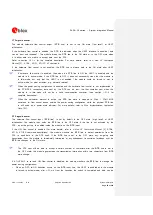
SARA-G3 series - System Integration Manual
UBX-13000995 - R06
Objective Specification
System description
Page 62 of 218
shows the case where in addition to the wake-up character further (valid) characters
are sent. The wake up character wakes-up the DCE UART. The other characters must be sent after the
“wake up time” of ~20 ms. If this condition is satisfied, the DCE recognizes characters. The DCE is
allowed to disable the UART and re-enters idle-mode after 2000 GSM frames from the latest data
reception.
CTS OFF
CTS ON
DCE UART is enabled for 2000 GSM frames (~9.2s)
after the last data received
time
Wake up time: ~20 ms
time
TxD
module
input
Wake up character
Not recognized by DCE
Valid characters
Recognized by DCE
Figure 21: Wake-up via data reception with further communication
The “wake-up via data reception” feature cannot be disabled.
In command mode
7
, if autobauding is enabled and the DTE does not implement HW flow control,
the DTE must always send a character to the module before the “AT” prefix set at the beginning
of each command line: the first character is ignored if the module is in active-mode, or it
represents the wake-up character if the module is in idle-mode.
In command mode7, if autobauding is disabled, the DTE must always send a dummy “AT” before
each command line: the first character is not ignored if the module is in active-mode (i.e. the
module replies “OK”), or it represents the wake up character if the module is in idle-mode (i.e.
the module does not reply).
No wake-up character or dummy “AT” is required from the DTE during a voice or data call since
the module UART interface continues to be enabled and does not need to be woken-up.
Furthermore in data mode7 a dummy “AT” would affect the data communication.
1.9.1.5
Multiplexer protocol (3GPP 27.010)
SARA-G3 modules have a software layer with MUX functionality,
3GPP TS 27.010 Multiplexer Protocol
[12], available on the UART physical link. The auxiliary UART and the DDC (I
2
C) serial interfaces do
not support the multiplexer protocol.
This is a data link protocol (layer 2 of OSI model) which uses HDLC-like framing and operates between
the module (DCE) and the application processor (DTE) and allows a number of simultaneous sessions
7
Refer to the
u-blox AT Commands Manual
[2] for the definition of the interface data mode, command mode and online command
mode.




































